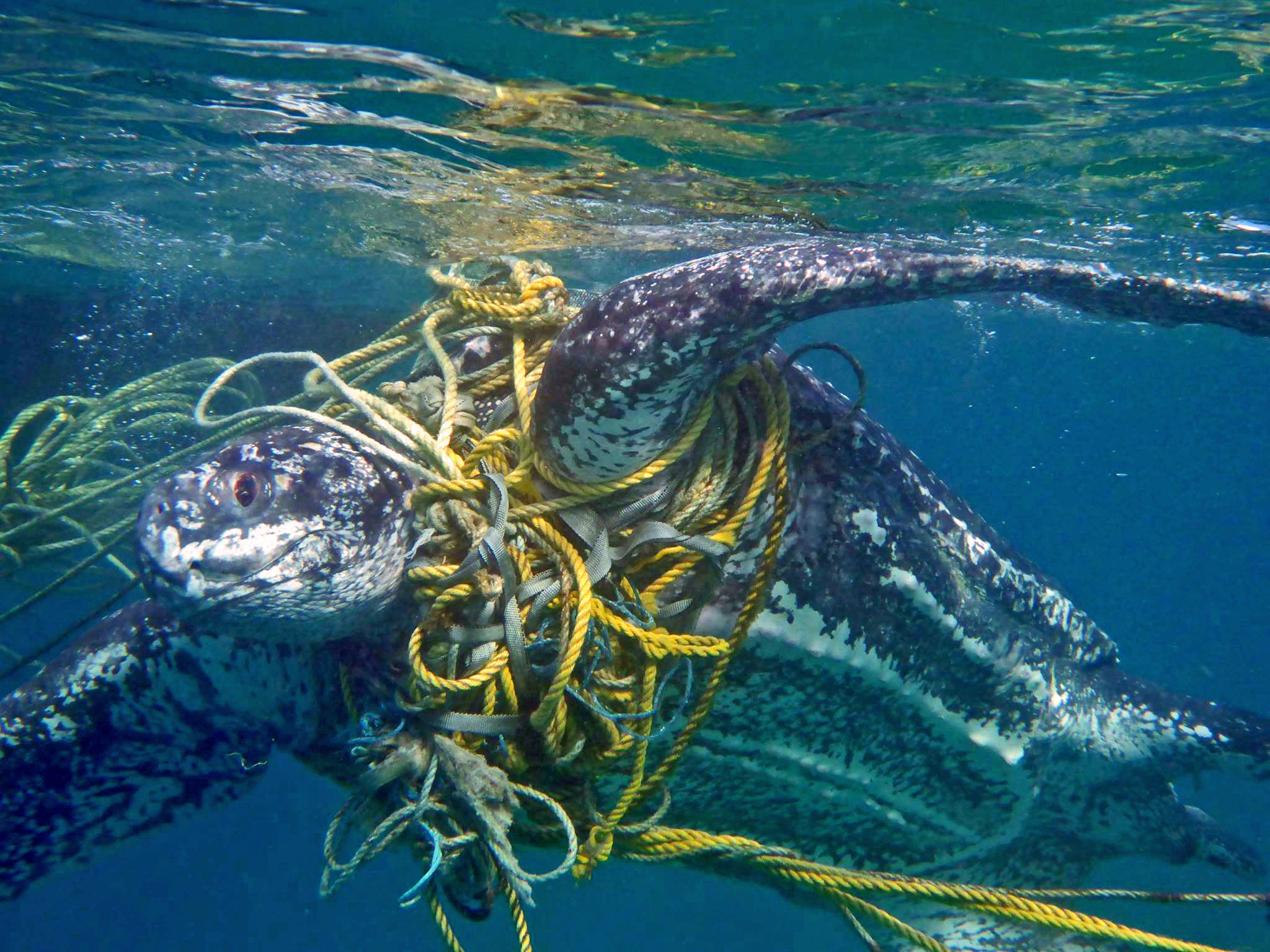Threats to Sea Turtles
Sea turtles are built to last. Equipped with unique body armor to protect them from their natural predetators, they have swum the seas since dinosaurs roamed the land. However, in recent history, rapidly increasing human populations have resulted in new and acute pressures, making sea turtle survival ever more difficult. Expert members of the IUCN-SSC Marine Turtle Specialist Group have identified five major threats to sea turtles worldwide: fisheries bycatch, coastal development, pollution and pathogens, direct take, and climate change. Learn more about these threats and find out how you can help.
Why Are Sea Turtles Endangered? 5 Major Threats
A leatherback entangled in fishing gear in Grenada. © Kate Charles
How Fisheries impact sea turtles
It’s estimated that fishery practices contribute to the death of thousands to tens of thousands of sea turtles each year. Often, sea turtles get accidentally entangled and drown in fishing gear such as longlines, gill nets, and trawls and are discarded as bycatch.
Sometimes fishing nets and lines break or are discarded as trash in the ocean, continuing to entangle sea turtles and other marine animals as they float freely in the ocean. Often, animals entangled in cast-off fishing gear, a.k.a. “ghost nets”, are unable to swim or feed effectively and don’t survive. In addition to sea turtle bycatch, fishing practices can also disrupt sea turtles’ food sources and habitats.
Sea turtle mortality in fisheries is one of the greatest threats to sea turtles and is considered the primary cause of many declining populations.
Recent research and conservation efforts have focused on developing solutions to bycatch for sea turtles. This has included such efforts as developing better pound nets, creating and implementing Turtle Excluder Devices (TEDs), illuminated nets that deter turtles, and many others.
A crowd watches a leatherback turtle nest in Florida. © Ted Swoboda
How Coastal Development impacts sea turtles
Every year, sea turtle habitats are destroyed because of shrinking coastlines. Wherever there is boat vessel traffic, whenever a new hotel or high-rise is built up along the shore and the coastline becomes more illuminated, and wherever there is seafloor dredging and beach erosion, sea turtle food supplies and nesting areas can be impacted.
A juvenile sea turtle covered in oil. © Carolyn Cole
How Pollution, Pathogens, and plastic impact sea turtles
Ocean pollution can harm sea turtles in many ways. Plastic pollution, inorganic pollutants, discarded fishing gear, petroleum by-products, chemical runoff, and other forms of pollution can injure sea turtles through ingestion or entanglement. Ocean pollution can also weaken turtles’ immune systems and disrupt nesting behavior and hatchling orientation. Learn more about sea turtles and plastic pollution.
A butchered green turtle for sale in Grenada. © Brian J. Hutchinson
How Direct take/Illegal Trade impacts sea turtles
Throughout the world, turtles are killed and traded on the global market as exotic food, oil, leather, and jewelry. Over the past 100 years, millions of hawksbill turtles alone have been killed just for the price of their shells. And even though today the global trade of luxury and craft items has reduced thanks to conservation efforts, it remains an ongoing threat to turtles in parts of Africa, Asia, and the Americas.
A bleached coral reef. © The Ocean Agency
How Climate change impacts sea turtles
We are just now learning the extent to which climate change impacts sea turtles. Climate change can impact the natural sex ratios of hatchlings, cause sea levels to rise and erode nesting beaches, increase the likelihood of disease outbreaks, and can escalate the frequency of extreme weather events that destroy nesting beaches and coral reefs. We are also seeing both nesting ranges and migration patterns shifting, likely in response to changes in sand and sea temperatures.





